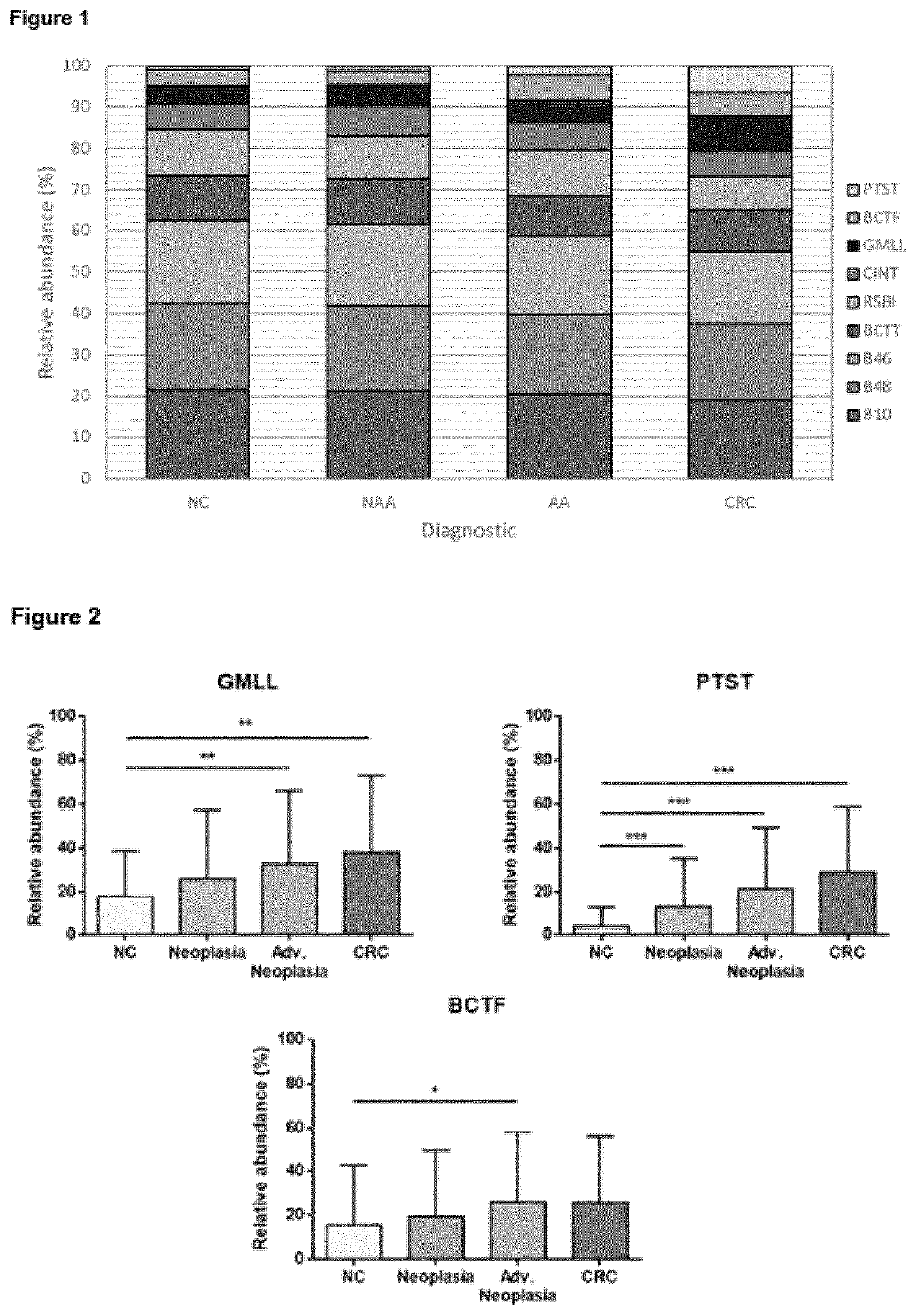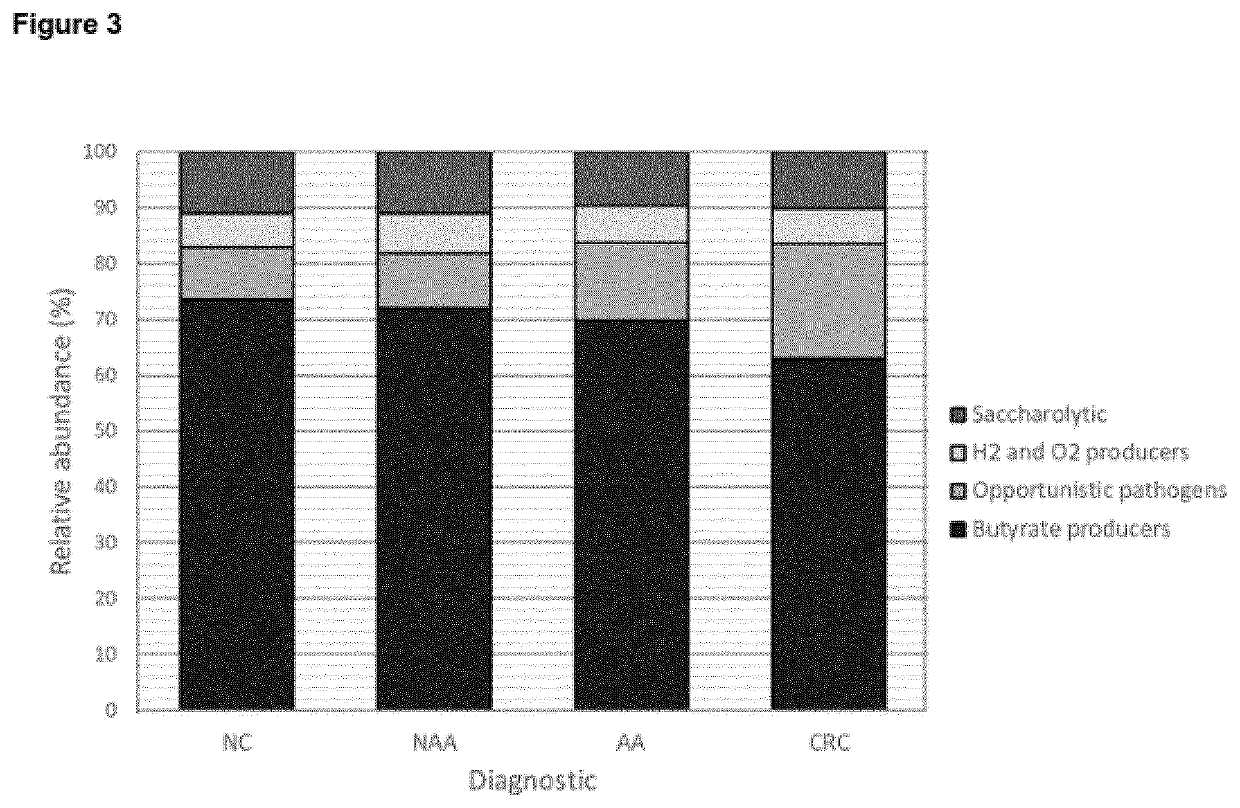Improved method for the screening, diagnosis and/or monitoring of colorectal advanced neoplasia, advanced adenoma and/or colorectal cancer
- Summary
- Abstract
- Description
- Claims
- Application Information
AI Technical Summary
Benefits of technology
Problems solved by technology
Method used
Image
Examples
example 1
and Methods
[0280]Study Population
[0281]A cohort consisting of 333 consecutive patients with CRC-related symptoms referred for a diagnostic colonoscopy from primary and secondary health care to Complexo Hospitalario de Ourense (Ourense, Spain) was recruited (Table 1). Exclusion criteria were: (1) asymptomatic subjects undergoing colonoscopy for CRC screening, (2) patients with a previous history of colonic disease undergoing surveillance colonoscopy, (3) patients requiring hospital admission, (4) patients whose symptoms had ceased within 3 months before evaluation, and (5) patients who had received antibiotic treatment within the last month prior to inclusion. The study protocol was approved by the Biobanco del Complexo Hospitalario Universitario de Vigo (Vigo, Spain). Written informed consent was obtained from all study patients.
TABLE 1Patients characteristics classified according to colonoscopy diagnostic. Hb, hemoglobin; FIT100(20 μg Hb / g of feces); CRC, colorectal cancer; AA, adv...
example 2
omarkers in Neoplasia Progression
[0299]The relative abundance of each bacterial marker was determined for each diagnostic (normal colonoscopy, non-advanced adenoma, advanced adenoma, CRC) (FIG. 1). Regardless of the colonoscopy diagnosis, three different butyrate producing species (B10, B46 and B48) were the most prevalent biomarkers with relative abundance values of 20.4%, 19.0%, and 20.0%, respectively. GMLL and PTST were significantly more abundant in CRC population than in normal colonoscopy individuals (p=0.006 and p<0.001, respectively) or non-advanced adenoma subjects (p=0.047 and p<0.001, respectively). Although with no significant differences, it could be observed a tendency of B46, being more abundant in CRC patients rather than in subjects with advanced adenomas (p=0.087). Interestingly, EUB abundance was maintained constant regardless of neoplasia status. Comparison among the different CRC stages (0, I, II, III, and IV) did not show significant differences in the abundan...
example 3
ST, and BCTF can Detect Advanced Neoplasia Lesions
[0300]The relative abundance of bacterial markers was compared after grouping subjects as follows: (1) normal colonoscopy, (2) neoplasia (non-advanced adenoma+advanced adenoma+CRC), (3) advanced neoplasia (advanced adenoma+CRC), and (4) CRC (FIG. 2). PTST was found to be highly correlated with neoplasia lesions (p<0.001). Regarding the detection of advanced neoplasia lesions, GMLL, PTST, and BCTF were potential biomarkers for their detection (p=0.006, p<0.001, and p=0.030, respectively). In terms of prevalence, these three opportunistic pathogens were found more often in patients with advanced neoplasia (GMLL, 64.9%; PTST, 58.4%; and BCTF, 44.7%) than in healthy subjects (GMLL, 53.5%; PTST, 26.1%; and BCTF, 29.8%).
[0301]Our results clearly indicate the existence of a bacterial dysbiosis in patients with CRC. The studied bacterial markers were classified according to gut health related phenotypes: butyrate producers (B10, B46, B48, RS...
PUM
| Property | Measurement | Unit |
|---|---|---|
| Mass | aaaaa | aaaaa |
Abstract
Description
Claims
Application Information
 Login to View More
Login to View More - R&D Engineer
- R&D Manager
- IP Professional
- Industry Leading Data Capabilities
- Powerful AI technology
- Patent DNA Extraction
Browse by: Latest US Patents, China's latest patents, Technical Efficacy Thesaurus, Application Domain, Technology Topic, Popular Technical Reports.
© 2024 PatSnap. All rights reserved.Legal|Privacy policy|Modern Slavery Act Transparency Statement|Sitemap|About US| Contact US: help@patsnap.com









